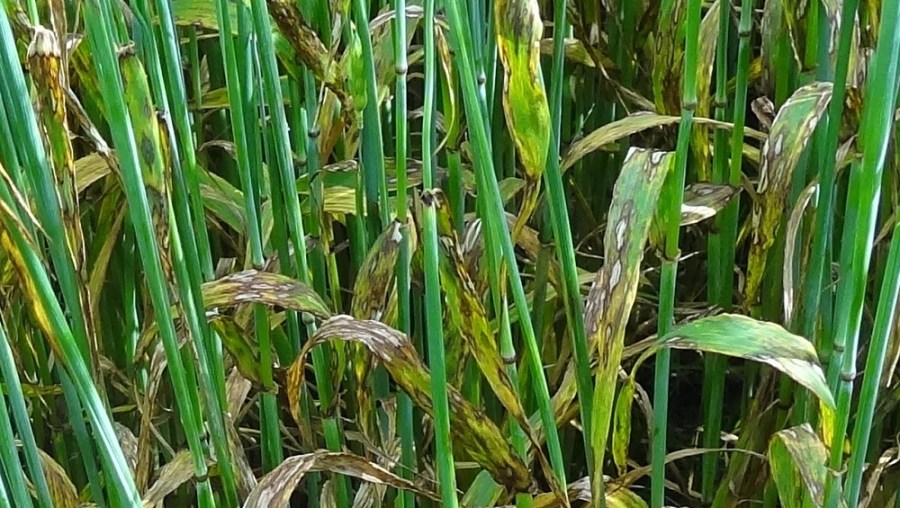The results of two new surveys show there’s room for greater attention to detail with barley disease control. CPM finds out more.
You can ring the changes across fungicide timings in barley.
By Rob Jones
Barley growers are concerned about the risk of rhynchosporium resistance to fungicides, yet many are failing to utilise variety resistance ratings fully in treatment decisions. Those were the messages from a new survey of winter and spring barley growers by Syngenta.
Conducted among 89 barley growers, results showed three quarters of respondents had concerns about the risk of rhynchosporium resistance building to fungicides – with 68% being fairly concerned and 8% very concerned.
Additionally, nearly 90% thought it was important to utilise different fungicide modes of action to reduce the chance of rhynchosporium resistance building. But when it came to utilising variety resistance ratings, results were less clear cut.

Barley is building up its own set of resistance problems, warns Fiona Burnett.
Less than 4 out of 10 of respondents (38%) always took this into account when deciding which fungicides to use. One in 10 admitted they didn’t take it into account and used the same programme on all varieties, and just over half (52%) said they only took it into account with particularly resistant or susceptible varieties.
According to leading crop scientist, Professor Fiona Burnett of SRUC, fungicide resistance is a key issue and there’s room for growers to improve on disease management in barley. There remains huge scope to match fungicides more closely to varieties grown, she believes.
Tricky Disease
“Rhynchosporium is already a tricky disease to manage and last season we saw a potential erosion of the strobilurins. We weren’t getting the control we expected and work with Teagasc and SRUC shows that the G143A mutation associated with strobilurin resistance is now present in the rhynchosporium population,” explains Fiona Burnett.
As far as the azoles are concerned, she says rhynchosporium mirrors other diseases, with the performance of older triazoles having slipped. At the moment, the latest azole chemistry is still giving good control, but she doesn’t expect it to remain altogether unaffected.
“There are also concerns about net blotch building mutations to strobilurins and now the SDHIs. Although the focus is mostly on septoria in wheat, barley is building up its own set of problems,” she adds.
Fortunately, barley provides scope to use a broad portfolio of fungicide active ingredients, rather than repeatedly relying on the same ones.
“There are multi-sites like chlorothalonil, but also a wider choice of systemics such as cyprodinil, which brings an extra active ingredient. You can ring the changes across the two to three fungicide timings in barley without compromising the effect,” she says.

Substituting at least one triazole application with another fungicide from a different group isn’t difficult in barley, says Iain Hamilton.
Syngenta field technical manager, Iain Hamilton, agrees that it’s simpler to rotate fungicide modes of action in barley and that the prospect of rynchosporium resistance isn’t taken as seriously as septoria shifts in wheat.
“Rather than repeatedly exposing triazoles in mix with an SDHI at T1 and T2, consider substituting at least one application with a cyprodinil treatment. For example, Cebara provides cyprodinil co-formulated with the persistent SDHI isopyrazam, and we’ve seen it match triazole plus SDHI for yield in trials.”
In practice, Fiona Burnett says growers all too often resort to a “one size fits all” in barley, applying the same fungicide programme across the whole farm. But it’s not a strategy that’s smart economically, she believes.
“It doesn’t take account of any of the factors that affect disease risk, such as variety differences, whether it’s a first or second barley, different topographies or drilling dates.”
There’s also evidence from a recent SRUC survey that although growers want to use resistant varieties they still commonly select susceptible ones to suit their market, so could be leaving some under-protected, she adds.
“We found 60% said they grew resistant varieties, but when you drilled down, actually only 23% were doing this. So they were over-estimating what the variety was providing. They also weren’t tailoring fungicide to variety.
“This season, it’s been a mild winter and crops are pretty advanced, so disease is lurking and there will be a roll-on risk to spring barley,” she adds.
As a starting point, Iain Hamilton urges growers to stay up to date with latest variety resistance ratings on the AHDB Recommended List. “If you look at hybrids as an example, they tend to have good rhynchosporium resistance but need more help against net blotch, whereas for some other barleys it’s the other way around.”




